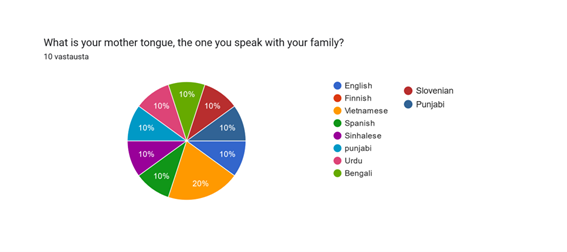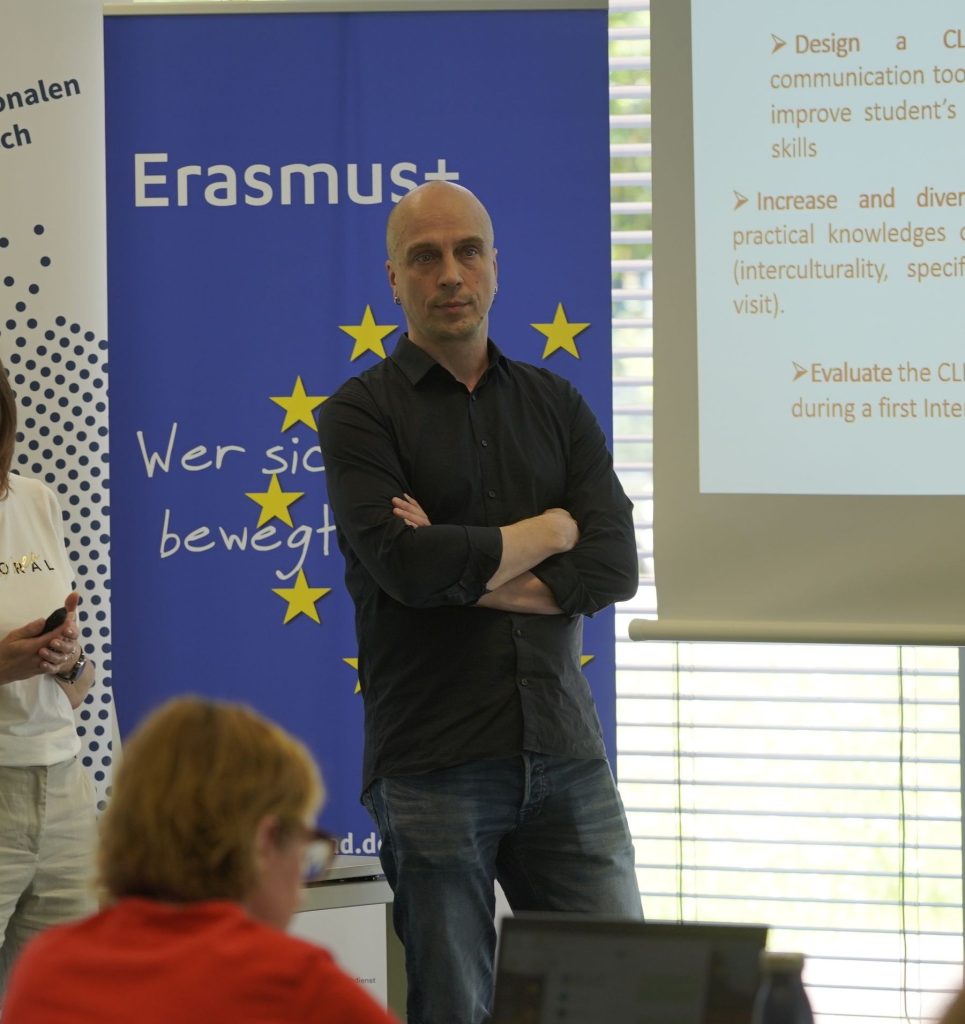Teaching team: Seppo Nevalainen and Heidi Vartiainen
University and degree programme: Karelia University of Applied Sciences, Information and Communications Technology
Courses: Digital Technology Essentials and Working in International Teams
Timing: 23.10. – 15.12.2023
CLIL pilot type: Light
CLIL assignments: Keeping a reflective learning diary, summarizing weekly key course takeaways, crafting and providing a group presentation.
Language: English
In this CLIL case example, a pilot between two first-year courses, an ICT-course about digital technology essentials and an intercultural communication course about working in international teams is described. We will cover planning, implementation, and assessment of these two courses, and the integration of several parts by using CLIL methodology. The teaching team had one content teacher from ICT and one English language and communication teacher.
Digital Technology Essentials -course started in October 2023 and lasted until February 2024. The course was 5 ECTS credits and was divided into two parts. The first part taking place in the Autumn semester and the second one in the spring semester. The pilot was implemented during the first part of the course. This was due to the fact that while the other course, Working in International Teams, started at the same time in October 2023, it already ended in December 2023 as it was 2 ECTS credits. Therefore, Working in International Teams course was entirely included into the CLIL-integration. Both courses used blended learning, since some of the students were still studying remotely from their home countries.
The CLIL-integration was mainly planned between August and October 2023, although initial discussions and brainstorming were carried out already during spring 2023. The CLIL tasks were selected so that they would support students in the starting phase of their studies, and covered conceptual scaffolding, developing subject-specific literacies and disciplinary languages, the use of teaching portfolios, intercultural competence in CLIL lessons, and cooperative and collaborative techniques.
After these CLIL tasks were decided, the teaching team discussed and decided on concrete assignments and their assessment criteria. Lectures were mostly planned and crafted separately, although some preparatory lectures for the CLIL tasks were coordinated and partly planned together. In addition, a form for CLIL method student survey was designed and created, so that we could collect student experiences concerning this CLIL pilot at the end.
Introduction of the CLIL implementation with 10 CLIL parameters
Sequence: CLIL integration lasted through the first part of Digital Technology Essentials course and through the entire Working in International Teams -course. Students were expected to keep a learning diary for every week of the entire period (8 weeks). Every two to three weeks, students were planned to have a CLIL group task for each course topic. Initially we planned three of these tasks during the CLIL integration period, but due to some practicalities, only one such task covering first three weeks was carried out. At the end of the CLIL integration period, students had one larger CLIL group task, in which they were asked as a multicultural group to prepare and carry out a presentation of a larger topic related to Digital Technology Essentials -course.
Concept and Task > Language: In their learning diaries, students were asked to:
- Summarize key takeaways of each week’s lectures, using the concepts and terminology provided in the DTE lectures.
- Reflect on their observations related to their personal communication and team communication in in their intercultural groups while they worked on the given tasks of both courses.
- Provide answers to the weekly exercises related to DTE course.
- Report both their initial definitions for digital technology concepts and the final definitions jointly agreed upon by their group for topic-wise tasks.
This way, students were able to practice English while learning fundamental digital technology content, methods and concepts that formed the basis for their developing professional know-how. During the classes of their Working in International Teams -course, the students got the understanding of the basics of intercultural communication skills and team dynamics. In addition, they had the opportunity to receive guidance on their written and spoken communication skills. Writing their weekly learning diaries functioned not only as a reflective tool for their learning experiences in intercultural teamwork and personal growth but also as a writing practice.
Guided multimedia input: Bothcourses were implemented as blended learning or hybrid teaching, since some of the students were able to take part in the course only virtually, while some attended the lessons in-person. Lectures, therefore, took place both remotely and in classrooms by using Zoom. The closing presentation seminar for the final CLIL group task were organized separately for teams who were on campus and teams who only participated online. Instructions for the learning diary and for the presentation were presented both through written instructions in Moodle and through verbal instruction provided in the lectures.
Key language: Based on the feedback questionnaire, students had at least nine different mother tongues (Figure 1). As English is the official language of the degree program, it was used for all communication. All students were expected to actively write their personal learning diaries in English and take part in the team assignments and closing presentation seminar. In their informal communication, students seemed to use mainly English due to their quite different language backgrounds and multicultural nature of the groups.

Figure 1. Languages represented by the students
Instructions: Teachers of both courses discussed and prepared the instructions beforehand, agreeing on who would be responsible for instructing which parts of the learning diaries and group task instructions. These instructions were provided as a part of the course Moodle for both Digital Technology Essentials-course and Working in International Teams-course. Moreover, they were also presented in the first lectures of both courses. During the courses, more detailed instructions were discussed, designed, and then consistently provided in the previous week before each upcoming CLIL task.
Interactions: The aim of the CLIL tasks was to foster discussions between students on key concepts and terminology of digital technology and provide them with opportunities to do so in multicultural teams. After formulating their own ideas, the students were instructed to engage in group discussions during which they were expected to present and compare their suggestions with those of their peers. During these discussions, students were expected to reach a consensus regarding the nature of key concepts and meanings of various key terms. The team discussions and assignments took often place in the course “Working in International Teams”. Additionally, the students were expected to dedicate their own time outside of lectures to working on their group tasks.
Thinking: During the CLIL tasks, the students were asked to identify the most relevant information from the lectures and course materials, and subsequently produce their own summaries of the main takeaways of each topic. This required active autonomous contemplation and decision making. Then, as the students worked in their intercultural teams (both in-person and online), they needed to compare their own choices to those of their peers, and through informed joint decision process form common answers through finding common elements in their individual summarizations and synthesizing them together. CLIL tasks were designed so that they would support students’ reflection on learned subject matters in a foreign language and encourage them to engage in problem-solving tasks and present their answers collaboratively as a group-effort.
Supported output: Guidance, requirements and instructions for the Learning Diary, and group presentations were provided in “Working in International Teams”. It seemed that many international students were not familiar with the concept of a reflective learning diary and encouragement, instructions, and repetition was needed throughout the course.
Feedback: For closing seminar presentations of the final group task, the students were provided brief oral feedback after group presentation for each group, and also general feedback was provided. Students’ feedback about the course was collected throughaCLIL method student survey. The results indicated that 70-90% of the students felt that “Working in International Teams” improved their written and verbal language skills, as well as communication and team working skills. The questions concerning the course “Digital Technology Essentials” concentrated on students’ ability to gain understanding of the main digital technology topics and concepts. The results were very high, between 70% and 100%. The responses regarding how “Digital Technology Essentials” supported students’ learning of the English language showed similar outcomes. In the open feedback about the CLIL approach, the students seemed to find the approach of studying technical topics through multicultural team work fun and effective. This approach also seemed to help students to become more closely connected with each other, improving the group dynamics. This can be considered as an important outcome, given that the students were not particularly familiar with each other or with different cultural backgrounds, especially since part of the study group was on campus while others were participating virtually.
Team teaching: As teachers, we found the overall experience positive. It seems that we were able to find natural points of integration between these two courses in CLIL tasks that involved group discussions and presentations. Based on the student feedback, these common activities did not come in the way of students’ learning of digital technology content or developing communication and team working skills in a foreign language. Instead, this CLIL approach seemed to provide a natural platform for new students from various background contexts to get to know each other.
Further development ideas: One thing to consider in the future is whether the two courses could have a joint Moodle. At times, it was challenging to provide separate instructions on different parts of integrated CLIL tasks in two separate learning environments. This seemed to cause some confusion also among some of the students. Different durations of the courses were also a bit problematic for the integration, especially since the final CLIL task was a group presentation that marked the end of only one course. This issue was brought up also in the student feedback.
Altogether, the piloting was a positive experience for both us teachers and the students. Many students reported that their skills to understand the basics of intercultural communication and communicating within intercultural teams had significantly improved while working on topics directly related to their field of study.

